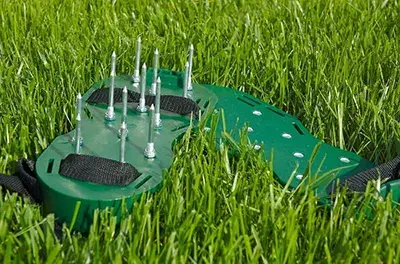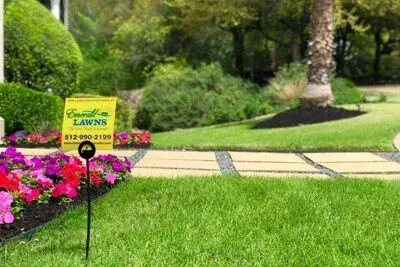Take-all patch, or root rot, is a fungal disease that affects St. Augustine and Bermuda grass lawns. It actually looks similar to chinchbug damage and large patch disease. The fungus responsible for take-all actually inhabits our soil, is found in various parts of Texas, and affects lawns both healthy and diseased in appearance (Young-ki Jo, TAMU). How do you identify take-all patch in your lawn? And how do you get rid of it? We’ll cover all this and more!
Sickly Symptoms
You’ll commonly see this fungal disease appear in the spring or early summer, but it is a potential threat regardless of the season, especially if your turf is stressed. Here’s what you’ll see when your lawn catches take-all patch:
- Discolored foliage, usually yellow to brown in appearance
- Wilted grass blades
- Turf thinned out in irregularly shaped patches
- Affected areas range from 1’-20’ in diameter
- Blackened, rotted roots that pull stolons easily from the soil

Prevent the Patch
Take-all patch spreads when infected particles of your lawn, like the grass, thatch, or soil, are moved to a new area. You don’t have to worry about mowers or foot traffic as these activities don’t typically cause the disease to spread.
How can you prevent this fungus from infecting your lawn?
- Take proper care of your grass, healthy turf can fight back
- Address the stress! Excessive shade (especially under Oak trees), injury from treatments, soil compaction, and extreme weather conditions are just a few reasons why your grass will break a cold sweat
- Improve drainage and encourage healthy root growth; excessive moisture invites disease!
- Aeration relieves soil compaction and reduces thatch buildup
- Follow the mowing regimen for your grass type and the season
Stop The Rot
Focus on lowering soil pH, aiming for neutral to slightly acidic levels. You can do this over time by applying ammonium sulfate and powdered sulfur mixed with deliciously decayed compost or peat moss. Here’s what that’ll look like:
- Powdered Sulfur: 3-5 lbs per 1,000 sqft per year
- Peat Moss: 1-2 bales (around 3.8 cubic ft) per 100 sqft for a single application, 1-2 times a year
- Ammonium Sulfate (or a quick-release soluble nitrogen): up to 1 lbs per 1,000 sqft a year
- St. Augustine: up to 4 lbs nitrogen fertilizer per 1,000 sqft a year
- Bermudagrass: up to 5 lbs per 1,000 sqft a year
- We also recommend our topdressing when treating take-all patch as the pine lowers your soil’s pH levels
Credit: Young-ki Jo, TAMU
https://cdn-de.agrilife.org/extension/departments/plpm/plpm-pu-033/publications/files/take-all-root-rot.pdf
It’s so important to understand that it will take time to heal, just as it took some time to show up. Unfortunately, there isn’t a quick fix; throwing new sod over the affected area will not fix the problem as it’s a soil-borne disease and will affect the new roots.
Our fungicide program tackles take-all patch, check it out!




